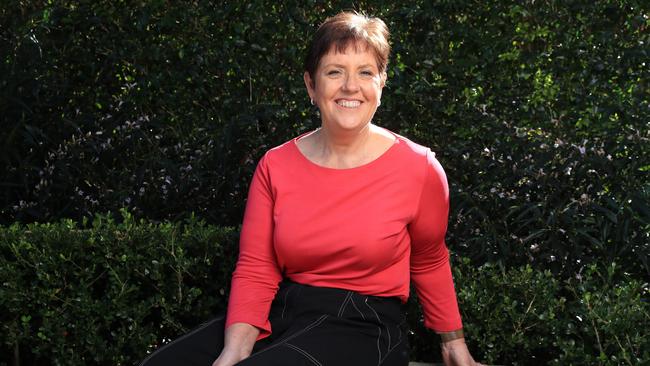AMP sees ‘positive signs’, but no dividend as first half profit rises 57pc
AMP under new boss Alexis George is undertaking a ‘massive simplification’ of its wealth division while it navigates Covid-19 lockdowns.

AMP’s new chief executive Alexis George wants to curb fund outflows across the business and return to inflows through 2022, as the group undertakes a “massive simplification” of its wealth division and navigates Covid-19 lockdowns.
Ms George - whose first priority is to oversee a spin-off of AMP’s prized private markets business by June 30 - on Thursday provided early insight into how she views the transformation challenge at the under-pressure group. She started in the role early this month, after a period of immense instability for the company.
AMP is making sweeping changes across pricing, fees and rationalising products and expenses in its under-pressure wealth division, which houses financial advice, investment platforms and superannuation.
“We are moving through a massive simplification program in our super business... we need to enhance the pricing there and we’ve got some further work to go in terms of the service,” Ms George said in an interview.
“On the advice side, we’ve got a way to go in terms of making that as efficient as possible.”
She also wants to elevate the role of technology at AMP, including potentially in her executive team, as the company looks at making financial advice more affordable to a larger proportion of the population.
“The superannuation and retirement systems in Australia are not getting any simpler ... good advice, in my view, is the real difference between having a comfortable retirement and not.
“We really as time goes on need to think about how we can use technologies better to deliver to the ordinary Australian an advice proposition that they are willing to pay for.”
Ms George’s comments came as AMP delivered increased first-half profits helped by investment income and the release of credit provisions, but stopped short of declaring an interim dividend.
AMP’s underlying profit grew 57 per cent to $181m for the six months ended June 30, compared to the same period a year ago. Statutory profit was lower, however, at $146m in the first half compared to $203m in corresponding 2020 period. The statutory result includes customer compensation and transformation costs, the gain on sale from the divestment of New Zealand Precinct Properties, and costs related to AMP’s portfolio review.
Net outflows plagued the earnings results of the AMP capital and wealth divisions.
AMP’s wealth unit suffered net cash outflows of $2.7bn in the first half, narrowing from $4bn net cash outflows in the same period last year. Cash outflows include $1bn in regular customer pension payments.
Ms George said the overhaul of the business alongside work to restore faith in the brand would help to stem outflows.
“I’d like to see us move to an inflow position. Is it going to be 12 months? I don’t know the answer to that, I think it will take some time... I’d like to see us in an inflow position through 2022.”
Lockdowns related to the latest Covid-19 outbreaks were creating uncertainty for staff and customers of AMP, but Ms George said impacts on real estate investments and mortgage repayment pauses were not yet notable. AMP’s exposures in airport investments in its infrastructure business have, however, felt some pain.
“To date it’s just over 100 customers that have asked for hardship (in the mortgage book) and we’ll have to continue to monitor that because I noticed now the ACT is in lockdown, Victoria, NSW is in lockdown and Queensland has been in-and-out, and we need to continue to watch that,” Ms George said.
She is not advocating mandating of Covid-19 vaccines for employees, although supports vaccination and has had both jabs.
“I can’t see a situation where we would mandate it for our staff unless there was some change in government policy or directives, however, I am strongly encouraging our staff to be vaccinated,” she added.
Investors cheered the AMP profit result, which beat analysts’ expectations. The stock climbed 3.2 per cent to close at $1.115 on Thursday, reflecting its strongest one-day gain in about nine weeks.
“AMP’s doing a reasonable job, and they’ve managed to attract some talented individuals,” said Allan Gray portfolio manager Simon Mawhinney. “Every so often I think the light at the end of the tunnel does appear.”
E&P analysts said the underlying profit result beat expectations, but was buoyed by the change in the loan impairment expense and lower group office costs.
“A better result aided by improved investment income,” they said.
AMP said the spin off of its private markets unit - which houses its real estate and infrastructure investments - was on track with an ASX listing expected after a shareholder vote slated for May. The company intends to retain up to 20 per cent of the private markets business on demerger, but Ms George said it was not a long-term holder of that stake.
Mr Mawhinney, an AMP investor, said he preferred a clean break between the entities.
“I don’t think AMP Capital needs AMP’s support on the (shareholder) register,” he added. “I’d be mortified if they didn't pivot away from that.”
The AMP board again opted not to declare a dividend on Thursday after not paying one in the latter half of 2020. It paid 10 cents a share in a special dividend in the first half 2020.
“The capital management strategy and payment of dividends will be reviewed following the completion of the demerger in 1H 22.”
AMP’s bank and NZ wealth management arms were the only divisions to post a rise in underlying profit, with the capital division seeing an 18.7 per cent drop in profit and wealth management unit posting a profit decline of 17 .2 per cent.
The banking division saw underlying profit climb 76 per cent to $88m, helped by improved economic conditions and the release of credit loss provisions.
AMP’s capital division saw earnings dented by challenging operating conditions and lower transaction and performance fees. Net outflows were $6.7bn, with a proportion of that due to Dexus taking over management of a large real estate fund.





To join the conversation, please log in. Don't have an account? Register
Join the conversation, you are commenting as Logout